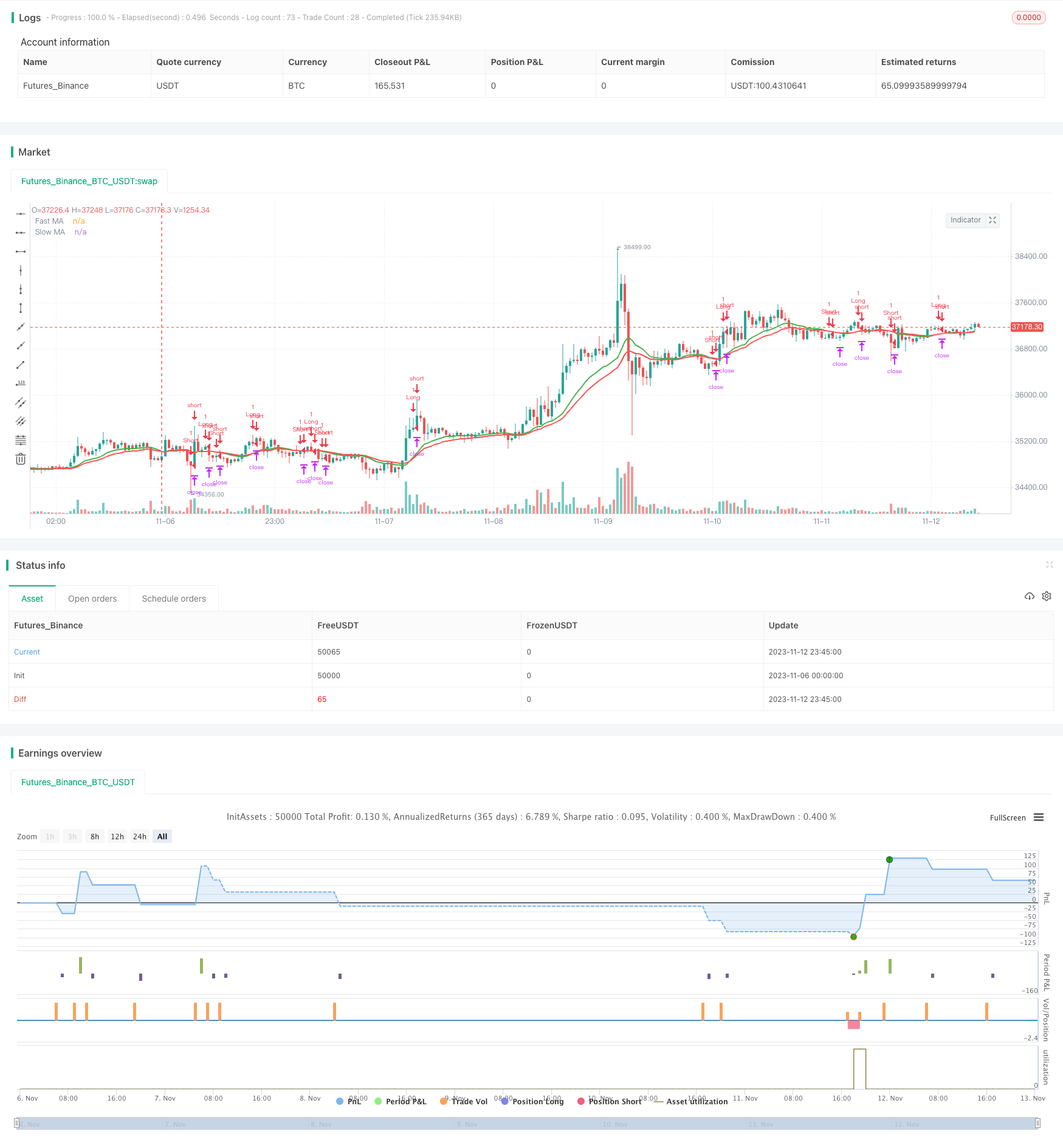
概述
本策略是在原有的双均线交易策略基础上,增加了时间限制模块,用于控制策略的启动时间。该模块可以有效管理策略的运行时间,降低非理想市场条件下的交易风险。
原理
策略使用快速MA和慢速MA构建交易信号。快速MA参数为14天,慢速MA参数为21天。当快速MA上穿慢速MA时生成买入信号;当快速MA下穿慢速MA时生成卖出信号。
策略还引入了交易反转选择,可以反转原有交易信号的方向。
时间限制模块通过时间戳比较当前时间和设定的启动时间,返回真值,来控制策略是否启动。该模块需要设置启动的年、月、日、时、分,只有当当前时间超过设置时间,策略才会启动。
优势
- 利用双MA形成交易信号,可以有效捕捉中短期趋势
- 增加时间限制模块,可以更精确地控制策略的运行时间,避免非理想市场条件下的不必要交易
- 交易反转选择增加了策略的灵活性
风险及解决
- 双MA策略可能会产生多次交易信号,带来更高的交易频率和交易成本
- 时间限制模块设置不当可能导致错过交易机会
- 交易反转选择不当可能导致交易信号错误
可以适当优化MA周期参数,降低交易频率。同时合理设置时间限制模块的启动时间,避免错过机会。最后,根据不同市场条件,审慎选择是否需要反转交易信号方向。
优化方向
- 增加止损模块,可以更好地控制单笔交易的风险
- 增加移动止损追踪,可以根据趋势逐步移动止损点,实现盈利的跟进提取
- 结合多个标的运算信号,可以提高信号质量,减少假信号
- 开发参数优化模块,可以自动寻找最佳参数组合
总结
本策略通过双MA形成交易信号,并加入时间限制模块控制策略运行时间,能够有效捕捉趋势,同时规避非理想市场条件下的风险。策略还可进一步通过优化参数设置、止损模块以及跨标的运算等手段进行提升,在降低交易频率的同时提高每笔交易的稳定性和盈利能力。
策略源码
/*backtest
start: 2023-11-06 00:00:00
end: 2023-11-13 00:00:00
period: 45m
basePeriod: 5m
exchanges: [{"eid":"Futures_Binance","currency":"BTC_USDT"}]
*/
//@version=2
strategy(title = "Strategy Code Example", shorttitle = "Strategy Code Example", overlay = true)
// Revision: 1
// Author: @JayRogers
//
// *** THIS IS JUST AN EXAMPLE OF STRATEGY TIME LIMITING ***
//
// This is a follow up to my previous strategy example for risk management, extended to include a time limiting factor.
// === GENERAL INPUTS ===
// short ma
maFastSource = input(defval = open, title = "Fast MA Source")
maFastLength = input(defval = 14, title = "Fast MA Period", minval = 1)
// long ma
maSlowSource = input(defval = open, title = "Slow MA Source")
maSlowLength = input(defval = 21, title = "Slow MA Period", minval = 1)
// === STRATEGY RELATED INPUTS ===
tradeInvert = input(defval = false, title = "Invert Trade Direction?")
// Risk management
inpTakeProfit = input(defval = 1000, title = "Take Profit", minval = 0)
inpStopLoss = input(defval = 200, title = "Stop Loss", minval = 0)
inpTrailStop = input(defval = 200, title = "Trailing Stop Loss", minval = 0)
inpTrailOffset = input(defval = 0, title = "Trailing Stop Loss Offset", minval = 0)
// *** FOCUS OF EXAMPLE ***
// Time limiting
// a toggle for enabling/disabling
useTimeLimit = input(defval = true, title = "Use Start Time Limiter?")
// set up where we want to run from
startYear = input(defval = 2016, title = "Start From Year", minval = 0, step = 1)
startMonth = input(defval = 05, title = "Start From Month", minval = 0,step = 1)
startDay = input(defval = 01, title = "Start From Day", minval = 0,step = 1)
startHour = input(defval = 00, title = "Start From Hour", minval = 0,step = 1)
startMinute = input(defval = 00, title = "Start From Minute", minval = 0,step = 1)
// === RISK MANAGEMENT VALUE PREP ===
// if an input is less than 1, assuming not wanted so we assign 'na' value to disable it.
useTakeProfit = inpTakeProfit >= 1 ? inpTakeProfit : na
useStopLoss = inpStopLoss >= 1 ? inpStopLoss : na
useTrailStop = inpTrailStop >= 1 ? inpTrailStop : na
useTrailOffset = inpTrailOffset >= 1 ? inpTrailOffset : na
// *** FOCUS OF EXAMPLE ***
// === TIME LIMITER CHECKING FUNCTION ===
// using a multi line function to return true or false depending on our input selection
// multi line function logic must be indented.
startTimeOk() =>
// get our input time together
inputTime = timestamp(syminfo.timezone, startYear, startMonth, startDay, startHour, startMinute)
// check the current time is greater than the input time and assign true or false
timeOk = time > inputTime ? true : false
// last line is the return value, we want the strategy to execute if..
// ..we are using the limiter, and the time is ok -OR- we are not using the limiter
r = (useTimeLimit and timeOk) or not useTimeLimit
// === SERIES SETUP ===
/// a couple of ma's..
maFast = ema(maFastSource, maFastLength)
maSlow = ema(maSlowSource, maSlowLength)
// === PLOTTING ===
fast = plot(maFast, title = "Fast MA", color = green, linewidth = 2, style = line, transp = 50)
slow = plot(maSlow, title = "Slow MA", color = red, linewidth = 2, style = line, transp = 50)
// === LOGIC ===
// is fast ma above slow ma?
aboveBelow = maFast >= maSlow ? true : false
// are we inverting our trade direction?
tradeDirection = tradeInvert ? aboveBelow ? false : true : aboveBelow ? true : false
// *** FOCUS OF EXAMPLE ***
// wrap our strategy execution in an if statement which calls the time checking function to validate entry
// like the function logic, content to be included in the if statement must be indented.
if( startTimeOk() )
// === STRATEGY - LONG POSITION EXECUTION ===
enterLong = not tradeDirection[1] and tradeDirection
exitLong = tradeDirection[1] and not tradeDirection
strategy.entry( id = "Long", long = true, when = enterLong )
strategy.close( id = "Long", when = exitLong )
// === STRATEGY - SHORT POSITION EXECUTION ===
enterShort = tradeDirection[1] and not tradeDirection
exitShort = not tradeDirection[1] and tradeDirection
strategy.entry( id = "Short", long = false, when = enterShort )
strategy.close( id = "Short", when = exitShort )
// === STRATEGY RISK MANAGEMENT EXECUTION ===
strategy.exit("Exit Long", from_entry = "Long", profit = useTakeProfit, loss = useStopLoss, trail_points = useTrailStop, trail_offset = useTrailOffset)
strategy.exit("Exit Short", from_entry = "Short", profit = useTakeProfit, loss = useStopLoss, trail_points = useTrailStop, trail_offset = useTrailOffset)